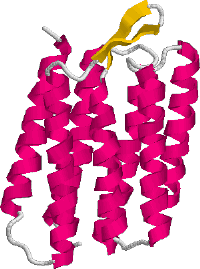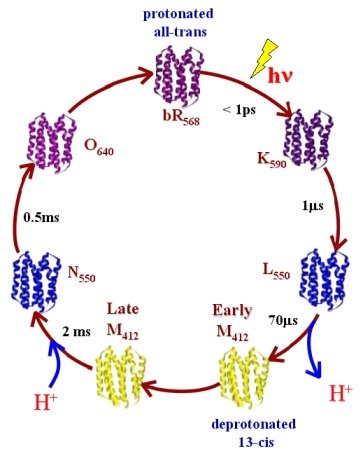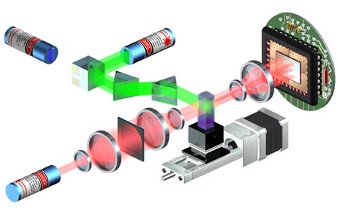|
Which
bacteria contain bR?
Structural
Properties
Functional
Properties
Technological
Importance
Which
bacteria contain bR?
(TOP)
 Bacteriorhodopsin
(bR) was discovered in membrane of Halobacterium salinarium by Stoeckenius and Oesterheltin in 1973. Halobacterium
salinarium
is extremely halophilic archaebacterium. This species of bacteria
can live in the habitats that have high salt concentration, such
as natural salt marshes and salterns, where salt is produced from
saltwater by evaporation. The main reason of the red colour in
these places is the red carotenoid pigments of Halobacterium. The
optimal salt concentration for this bacterium is between 20-25%.
This level of the salt concentration is 6-7 times higher than the
seawater. Bacteriorhodopsin
(bR) was discovered in membrane of Halobacterium salinarium by Stoeckenius and Oesterheltin in 1973. Halobacterium
salinarium
is extremely halophilic archaebacterium. This species of bacteria
can live in the habitats that have high salt concentration, such
as natural salt marshes and salterns, where salt is produced from
saltwater by evaporation. The main reason of the red colour in
these places is the red carotenoid pigments of Halobacterium. The
optimal salt concentration for this bacterium is between 20-25%.
This level of the salt concentration is 6-7 times higher than the
seawater.

Tuz
Lake (Turkey)
Structural
Properties
(TOP)
 The
structure of bR was first determined in 1975 by Richard Henderson
and Nigel Unwin using electron micrographs (7 ┼) of the purple
membrane. Clarification studies of the molecular structure of the
bR via cryo-EM (3,4 ┼) were carried out by Henderson et al in
1990. More detailed information about the structure of bR in 1.5
┼ resolution scale was obtained by novel research activities of
several laboratories in 1999. The
structure of bR was first determined in 1975 by Richard Henderson
and Nigel Unwin using electron micrographs (7 ┼) of the purple
membrane. Clarification studies of the molecular structure of the
bR via cryo-EM (3,4 ┼) were carried out by Henderson et al in
1990. More detailed information about the structure of bR in 1.5
┼ resolution scale was obtained by novel research activities of
several laboratories in 1999.
Bacteriorhodopsin
is a 26 kDa weighed integral membrane protein which pumps protons
across the membrane by using sunlight. 3D structure of the bR is formed by the arrangement of 248 amino
acids in seven transmembrane helical segments.A all-trans retinal
chromophore of bR is enclosed within these helical segments.This
retinal chromophore is a derivative of the ▀- carotene, and it is
bound via protonated Schiff base to ε-amino group of
Lysine-216 near the center of helices and lies nearly parallel to
the plain of membrane. It
is found in the cell membrane with a higher concentration ratio
with respect to the other membrane proteins. Due to high
concentration of bR, the bacterial membrane has a purpleľpatched
appearance.

Hexagonal
structure of Purple Membrane
Functional
Properties
(TOP)
 bR
pumps the proton from the inside of the cell to the outside by
using the energy it received from sunlight, and as a result,
a proton gradient occurs across the membrane. With the
enforcement of this generated proton gradient, protons are driven
to inside of the cell through the ATP-synthase, in order to
balance proton concentrations between these two environments. In
this step, The ATP-synthase provides the production of the ATP
using protons, therefore, the energy that the cell required for
would be produced. bR
pumps the proton from the inside of the cell to the outside by
using the energy it received from sunlight, and as a result,
a proton gradient occurs across the membrane. With the
enforcement of this generated proton gradient, protons are driven
to inside of the cell through the ATP-synthase, in order to
balance proton concentrations between these two environments. In
this step, The ATP-synthase provides the production of the ATP
using protons, therefore, the energy that the cell required for
would be produced.
bR
follows a cyclic pathway during proton pumping. bR shows some
conformational alterations along with the sunlight. There are some
determined transition circumstances of the protein in these
alterations, these circumstances are called intermediate, and the
intermediates shows the maximum absorption values that are used
for nomenclature of the intermediates like this respectively; bR568,
K590, L550, M412, N550, O640.
Technological
Importance
(TOP)
 Bacteriorhodopsin
(BR) is the key protein for the halobacterial photosynthetic
capabilities and is one of the very rare molecules which occur in
crystalline form in nature. Since its discovery, which was
reported in 1971, many efforts have been made to exploit the
obvious technical potential of this molecule. Successful
application of gene technology methods for the modification of the
physical function of a biomolecule was first demonstrated with BR.
This approach points the way to a new class of materials derived
from evolutionary optimized biomaterials by genetic
re-engineering. Mutated BRs proved to have significant advantages
over the wild type in optical applications. The current status of
potential technical applications of BR is reviewed. BR is employed
as a photoelectric, photochromic or energy- converting element.
First systems now exist which demonstrate the successful
integration of this new material into existing technologies.
Analyzing the patents filed, which claim the processing or
application of BR, gives an indication to areas where further
technical uses are to be expected in the near future. (N.A.Hampp Appl. Microbiol. Biotechnol. (2000) 53:
633-639.) Bacteriorhodopsin
(BR) is the key protein for the halobacterial photosynthetic
capabilities and is one of the very rare molecules which occur in
crystalline form in nature. Since its discovery, which was
reported in 1971, many efforts have been made to exploit the
obvious technical potential of this molecule. Successful
application of gene technology methods for the modification of the
physical function of a biomolecule was first demonstrated with BR.
This approach points the way to a new class of materials derived
from evolutionary optimized biomaterials by genetic
re-engineering. Mutated BRs proved to have significant advantages
over the wild type in optical applications. The current status of
potential technical applications of BR is reviewed. BR is employed
as a photoelectric, photochromic or energy- converting element.
First systems now exist which demonstrate the successful
integration of this new material into existing technologies.
Analyzing the patents filed, which claim the processing or
application of BR, gives an indication to areas where further
technical uses are to be expected in the near future. (N.A.Hampp Appl. Microbiol. Biotechnol. (2000) 53:
633-639.)

3D Memory of bR designed
by Birge Group
[ Back ] [ Up ] [ Next ]
[ Home ] [ Members ] [ Researches ] [ Publications ] [ Photos ] [ E-mail ]
|
